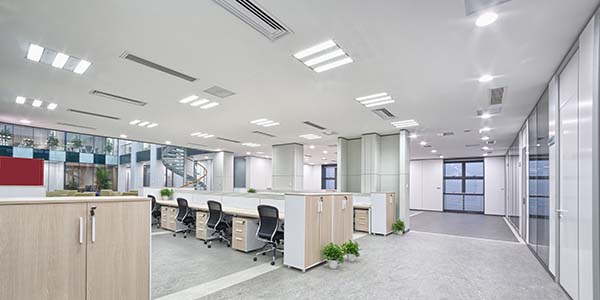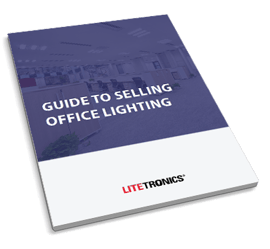 There have been plenty of changes to commercial office space over the last year. Hybrid work schedules, shared spaces, and more are prompting businesses to rethink how they use—and light—their spaces. In addition, many businesses have set aggressive goals for reducing their carbon footprint.
There have been plenty of changes to commercial office space over the last year. Hybrid work schedules, shared spaces, and more are prompting businesses to rethink how they use—and light—their spaces. In addition, many businesses have set aggressive goals for reducing their carbon footprint.
If you’ve sold commercial office lighting before, you know how important proving ROI is for business owners and facility managers.
But these days, ROI isn’t going to be enough to close the deal.
In this article, we’ll be discussing a few other concerns you’ll want to address and how to sell the smarter, more efficient, and more flexible LED lighting solutions today’s commercial office spaces demand.
Tip #1: Know Your Audience
What appeals to one customer may not move the needle for another. Here are some insights on the priorities and information needs of a company’s decision makers.
Facilities Manager or Property Management Firms
Priority one for this audience will be the yearly operational cost of the facility. Help them understand the value of an LED lighting upgrade by showing the potential savings in:
- Electricity cost – Use an ROI calculator to show the change in costs from LED. Remember to show them both what they will save and the excess they will continue to spend by not upgrading.
- Maintenance cost – Add up the cost of replacement bulbs or fixtures, the cost of bulb storage space, if any, and the expense of disposing of old bulbs that contain mercury.
- Labor cost – Every bulb that gets replaced comes with a labor cost that can be calculated by multiplying the time spent for each replacement, times the hourly wage of maintenance staff, times the number of replacements made annually.
Don’t Forget to Mention
LEDs offer plenty of benefits customers may not have considered. You can reassure customers your solution will address facility concerns, like:
- Product quality
- Warranties
- Manufacturer reputation
- Rated life of the product
- Reduced maintenance
- Keeping dust or bugs out of fixtures
- Disposal cost of their existing fixtures
Business Owners
Office space is already a big expense for business owners. Any upfront costs that may hit the balance sheet will need to be justified in tangible benefits, like:
- Return on Investment: Like facility managers, business owners will be focused on the numbers. Like any long-term investment, they will want to fully understand the break-even term and will appreciate seeing the pros and cons of upgrading versus keeping the status quo. Showing the calculations that go into your numbers will give them confidence to decide.
- Upfront cost: An LED upgrade project will have to make sense in the business owner’s budget terms. If you can offer options for financing, it will go a long way in helping them fit the project into their financial picture.
- Rebates: Rebates and incentives offered by utilities or governments can be the deciding factor in an LED upgrade, especially if there is a board of directors overseeing the process. If customers can land the right rebates, it can reduce their upfront costs by 50%-75%. Anything that offsets upfront costs or removes them altogether will greatly improve the likelihood of project approval.
- Productivity and Morale: Business owners are also employers. And they’re concerned about occupant safety, user experience and productivity. Clue them in on the impact poor lighting can have on employee comfort and morale.
Don’t Forget to Mention
LED technology and the pros and cons of different lighting solutions aren’t likely to be familiar territory for business owners. You can’t assume all the benefits are understood, so be sure to cover these advantages:
- Productivity benefits for employees of better lighting
- Less disruption to the office environment from frequent bulb replacement
- Eliminating the labor and material costs of ongoing maintenance
- Less business downtime during the install by using retrofit kits
- Added functionality and professionalism in office spaces like dimming or scenes
- Added cost savings from smart features like occupancy sensors
- Better light quality from fewer fixtures
Tip #2: Understand Available Smart Features for Commercial Office Lighting
Flexibility is and will continue to be a top priority for commercial office spaces, whether it is to accommodate an open office plan, multiuse spaces or subleasing of underused areas.
At the same time, businesses are looking for the best in energy savings.
Smart features offer both active and passive methods to save energy for commercial office spaces. Customers may think of smart functionality as a nice-to-have, but it offers a powerful one-two punch of lighting flexibility and energy efficiency.
Occupancy sensing or scheduling – Have the customer list every area in the office that isn’t used 100% of the time. Include restrooms, copy rooms, conference rooms, storage areas, etc. These are all spaces that can be outfitted with occupancy sensors to save energy when not in use.
These sensors are ideal for situations where the occupant may not know where the light switch is or does not have their hands-free. Additionally, because occupancy sensors automatically turn the lights off when no occupancy is detected for a while, they can quickly pay for themselves in energy savings.
Daylight harvesting – Customers can make use of the available sunlight with sophisticated sensors that can differentiate daylight from light generated by a LED source. As the ambient light level from outside rises and falls throughout the day, the output level of the LED lighting system is adjusted accordingly.
Harvesting available daylight can create a more productive work environment while reducing energy costs. The benefits in energy consumption and decreased carbon use are obvious, making this advanced feature a no-brainer for customers in interior spaces and exterior ones like parking garages.
Emergency lighting - The clear benefit of emergency lighting is employee safety. Because facilities that aren’t in compliance face the risk of being fined (or worse), customers will be relying on your expertise to recommend the right emergency lights and features.
Litetronics’ emergency lights and emergency backup batteries come with an automatic monthly self-testing function that is complemented with a status indicator light to show it is fully charged, in emergency mode, or about to run out of power. Manual testing via optional remote is an add-on you may want to offer.
Lighting Controls - LED lighting can be customized using control technology. And that relieves the customer of having to make all the decisions about light quality at the time of install—or requiring a return visit from your company to make adjustments.
Many Litetronics products come with adjustable wattage and color temperature that can be controlled via remote over Bluetooth. In addition, a wireless remote switch can also be used to control everyday functions of a fixture. Remote control enables quick adjustments like on/off, dimming, daylight harvesting and scene selection.
Tip #3: Be Prepared to Discuss Carbon Footprint Reduction
Lighting accounts for nearly 5% of global CO2 emissions. A global switch to energy efficient LED technology could save over 1,400 million tons of CO2 and avoid the construction of 1,250 power stations.
How businesses handle their energy savings isn’t just an internal decision anymore. Consumers prefer to buy from companies that are taking steps to reduce carbon footprints. According to an online survey by Nielson, 81% of global respondents feel strongly that companies should help improve the environment.
As larger companies focus more heavily on reducing their carbon footprint, you’ll need to be prepared to discuss how your upgrade plan will contribute to their overall goal. You can be sure your competitors are making this point!
Bright Ideas for Commercial Office Lighting
This heightened focus on super-efficient, high-flexibility lighting isn’t a passing trend – it’s a revolution. You should expect that all commercial office spaces will want to you to bring all this knowledge to the table to help them understand and appreciate the value of an LED lighting upgrade.
All the tips provided in this article, and more, are covered in our e-book: Guide to Selling Office Lighting. In it, we go in-depth on the different ways office space is used and how to talk up the advantages of LED office lighting so your company is the obvious choice for the project.



